A plug-and-play marketing opportunity
by carly_mchugh | 26 October 2023 2:53 pm
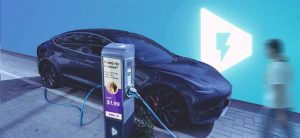 [1]
[1]The electric vehicle (EV) charging station infrastructure market is booming worldwide. Images courtesy Broadsign
By Catherine Lee
The electric vehicle (EV) charging station infrastructure market is booming worldwide. Valued at US$6.4 billion (C$8.7 billion) in 2023, it is expected to expand at a compound annual growth rate (CAGR) of 18.5 per cent by 2030, according to a report from Global Data.1 While ample opportunity abounds for media owners and EV charging startups looking to enter the market, competition is fierce. Cutting through the noise requires a dedicated approach to attracting and retaining customers. Adding a digital display that can play video, ads, and other visual content can help a network stand out and drive incremental revenue.
These emerging digital out-of-home (DOOH) displays unlock new opportunities to connect with climate-conscious consumers, which is a highly desirable audience for advertisers. Whether promoting a brand, restaurant, retail store, or event in the surrounding area, or another product or service, EV charging station advertising is opening up new ways for companies to interact with users through more personalized, contextually relevant content from the moment they step out of their cars. This is not only a potential gold mine for advertisers looking to market their products and brands, but it is also a huge revenue generator for EV charging networks.
However, to make the most of this emerging market, it is essential to examine the challenges currently facing the industry, as well as its promising future.
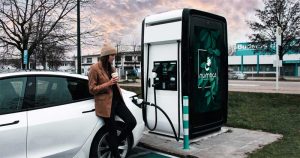 [2]
[2]Eighteen per cent of cars sold globally this year are expected to be EVs.
EV charging networks: Revenue pitfalls or revenue generators?
According to the International Energy Agency, 18 per cent of cars sold worldwide this year are expected to be EVs.2 With more of these types of vehicles taking to the road, companies are working to rapidly meet the demand with networks of conveniently located charging stations. The environmental benefits are clear, as studies show driving an EV produces a smaller carbon footprint than driving a gas-powered vehicle over its lifespan.3 However, the upfront installation and ongoing maintenance costs of chargers can be a hindrance.
To ensure the availability of convenient, affordable, publicly accessible chargers and offset some of these installation costs, many governments are subsidizing the creation of EV infrastructure. While those contributions are helpful to the networks, there are other maintenance and incidental ownership costs to consider. For example, commercial EV chargers often involve a costly network connection and payment processing system.
While one might think the charge profits could go towards these costs, the electricity service itself does not yield a massive return. Many EV owners opt to recharge at work or at home, largely for convenience.4 The charging locations they gravitate to outside of these areas also tend to be based on this factor. For these reasons, capturing the business of these audiences requires competitive, low-cost charging services spread across convenient, high-traffic locations. Similar to gas stations, which have been found to generate a majority of profits from on-site convenience store purchases, EV charging stations without a DOOH display or on-site retail outfit likely do not stand to gain a high profit margin.5 This is partly why more EV charging networks look to DOOH advertising as a self-sustaining path to profit. Savvy business owners are quickly realizing the revenue potential in leveraging DOOH displays to not only engage more meaningfully with their EV charging customers, but also to make this audience more accessible to advertisers, whose spend can help offset maintenance costs and greatly enhance their profit margins.
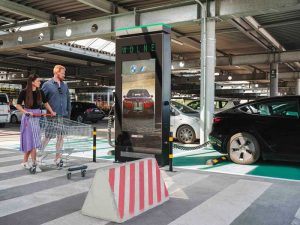 [3]
[3]Adding a digital display that can play video, ads, and other visual content can help a network stand out and drive incremental revenue.
The future of charging station advertising
Just as EV adoption rates are starting to climb and networks are beginning to proliferate, advertisers are seeking out new ways to engage with consumers in a more meaningful way. Personalized, contextually relevant content is one way to achieve this, especially amidst all the clutter seen on digital channels today and the demise of the third-party cookie. In this climate, more brands are looking to advertising channels such as DOOH to reach their audience with outstanding creative and messaging.
Within the DOOH landscape, advertisers are attracted to EV charging stations for their unique appeal. Equipped with full-screen digital displays, they provide a non-traditional approach to reaching audiences in the locations they frequent most, be it shopping centres, restaurants, entertainment complexes, or other venues. However, it is not just the location of the EV chargers that presents new opportunities. According to a recent survey, EV owners tend to have more disposable income, making them a highly desirable demographic for advertisers. Further, consumers at large have become “greener” in their purchasing decisions, with more than 50 per cent of the general population saying they would be more interested in doing business with a company that is committed to sustainability efforts.6,7
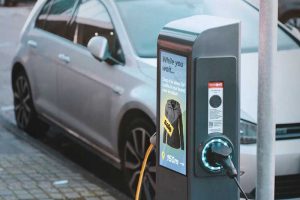 [4]
[4]Depending on the software setup of the EV charger display, an advertiser could surface relevant content based on the amount of charge time required for a specific vehicle.
EV charging stations outfitted with ad displays continue to pop up around the world, making it difficult for advertisers to ignore their promise. Since EV screens are almost always positioned at eye level in locations with high vehicle or foot traffic, they are not only able to easily capture the interest of carbon-conscious EV owners, but also the attention of passersby. Advertisers can even take their engagement one step further by integrating interactive content, QR codes, or hashtags into EV charger display ads, to drive both audiences online. However, EV charger owners and advertisers have not even begun to scratch the surface of what is possible. As more brands and local businesses experiment with the channel, they are uncovering a host of advantages to the place-based strategies it offers.
The point-of-purchase advantage
Modern marketers—and consumer packaged goods (CPG) brands in particular—want to pursue customers closer to the point of purchase, and EV charging stations equipped with ad displays provide a solution. Located near retail centres and other essential business outfits, these chargers open the doors for brands to engage with consumers shortly before making purchase decisions. This is crucial, considering two-thirds of shoppers have reported noticing out-of-home (OOH) ads while enroute to retailers, and when they are located very close to or right outside a store.8
Further, a survey revealed most climate-conscious consumers would spend more time shopping at retail and grocery stores if waiting for a vehicle to charge.9 Depending on the software setup of the EV charger display, an advertiser could surface relevant content based on the amount of charge time required for a specific vehicle. For example, an ad might propose a driver spends time at a nearby cafe when the average charge is estimated to take 30 minutes or longer.10
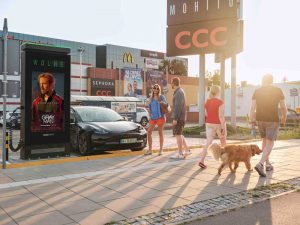 [5]
[5]EV charging stations are poised to generate new revenue beyond the sale of electricity, turning their networks into a viable, profitable business.
Brand perception matters
On average, millions of consumers have reported an inclination to engage more with a brand focused on sustainability.11 However, commanding the attention of these consumers in an oversaturated online space can be difficult, between “banner blindness” and digital screen fatigue.12 EV charger advertising tackles both realities: first, enabling splashy digital content that grabs the attention of consumers at unique moments throughout their days; and second, helping to ensure a more positive perception of the brand amongst climate-conscious audiences.
Climate change is not a temporary concern, unlike many other factors that can influence ad performance today (i.e. weather, news, and trending social media hashtags). More consumers, especially gen-Zers and millennials, are showing interest in interacting with brands that demonstrate a constant commitment to long-term positive climate action. Advertising on EV charging stations creates a unique opportunity for brands to authentically demonstrate this commitment.
A myriad of business opportunities
EV charging stations outfitted with ad displays are poised to generate new revenue beyond the sale of electricity, turning EV charging station networks into a viable, profitable business, versus a public utility working to offset operational and maintenance costs. Plus, as the display technology continues to evolve, the content these screens are capable of playing will only become more dynamic.
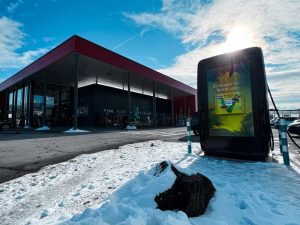 [6]
[6]EV charger advertising enables splashy digital content to grab the attention of consumers and helps ensure a more positive perception of brands amongst climate-conscious audiences.
At the same time, in-screen sensors will become more capable of recognizing movement, and data from Wi-Fi-enabled mobile devices will make it possible to better measure the effectiveness of DOOH ads, such as those that run on EV charger displays. More tools will also emerge to help advertisers and EV charger owners use anonymized audience data to deliver messaging tailored to the demographics of the environment in which the charger sits. This will enable more granular audience targeting and make the medium even more attractive to advertisers.
All these developments point towards a bright future for EV charger advertising. While starting and powering an EV charger advertising network or inventory may seem daunting, leveraging cloud-based software tailored for digital outdoor advertising can streamline the process. As a result, scheduling can be automated; programmatic transactions are possible; and inventory can be rebalanced to accommodate more campaigns, optimize messaging delivery, and maximize ad profits.
Notes
1 See “Electric Vehicle (EV) Charging Infrastructure Market Size, Share, Trends, and Analysis by Region, Level, Power, and Segment Forecast to 2030,” published by Global Data. For more information, visit https://www.globaldata.com/store/report/ev-charging-infrastructure-market-analysis/#:~:text=The%20global%20electric%20vehicle%20charging%20infrastructure%20market%20will,rate%20%28CAGR
%29%20of%2018.5%25%20over%20the%20forecast%20period.
2 Read “Electric Vehicle Market Update: H1 2023 in Review,” by Priscila Barrera, published by Investing News Network. For more information, visit https://investingnews.com/electric-vehicle-forecast.
3 Consult “Net Emission Reductions from Electric Cars and Heat Pumps in 59 World Regions Over Time,” by Florian Knobloch et al., published by Nature. For more information, visit https://www.nature.com/articles/s41893-020-0488-7.epdf?sharing_token=9VBdz-6VbqF-yVdUSa1YBdRgN0jAjWel9jnR3ZoTv0OMBHrNGD6k2npei17x4aWWLctOfIoyfalbH9WNy5EPZJy9w30IYeodKn1h_MDWDHVs
Fp0mmyULysHIj9L3dHmXqwchSvZ42GIPpNYkjIyI-jbqfPasm5iotJlatJ78r_-0KRqb70vd_KoRzQR0OiFIybySQ-_FrdMxOsL-wFeZzg%3D%3D&tracking_referrer=www.cnbc.com.
4 Refer to “Most EV Charging Still Done at Home; Work, Restaurant Chargers Also Popular,” published by Canadian
Auto Dealer. For more information, visit https://canadianautodealer.ca/2022/09/most-ev-charging-still-done-at-home-work-restaurant-chargers-also-popular/#:~:text=In%20an%20effort%20to%20study%20and%20expand%20access,and%20half%20of%20respondents
%20also%20charge%20at%20restaurants.
5 Read “Economics of a Gas Station,” by Martha C. White, published by NBC News. For more information, visit https://www.nbcnews.com/business/business-news/economics-gas-station-rcna19516.
6 Consult “EV Consumer Behavior,” published by Transportation Energy Institute. For more information, visit https://www.transportationenergy.org/research/reports/ev-consumer-behavior.
7 See “Volta Formally Launches Volta Media Network: Connecting Brands to the Largest Audience Shift in a Generation,”published by Volta. For more information, visit https://voltacharging.com/press/volta-formally-launches-volta-media-network#:~:text=35%25%20of%20U.S.%20adults%20say,commits%20to%20various%20sustainability%20efforts.
8 Refer to “Over Two-Thirds of Shoppers Notice OOH Ads Enroute to Retailers, According to Research from OAAA & Morning Consult,” published by Yahoo Finance. For more information, visit https://finance.yahoo.com/news/over-two-thirds-shoppers-notice-120000891.html?fr=sycsrp_catchall&guccounter=1.
9 Read “Volta’s Consumer Study Reveals Climate is Top of Mind for 55% of U.S. Consumers and Advertisers Must Lead with Innovation to Sell to this Cohort,” published by Volta. For more information, visit https://voltacharging.com/press/climate-conscious-consumer-study-2022.
10 Consult “How EV Charging Boosts Retail Sales,” published by Greenlots. For more information, visit https://greenlots.com/wp-content/uploads/2020/11/Retail-Insights.pdf.
11 See Note 9.
12 Refer to “What is Banner Blindness? How Can You Avoid It?” by Kayla Carmicheal, published by Hubspot. For more information, visit https://blog.hubspot.com/marketing/banner-blindness?__hstc=186087094.f6e58543fe8962b222bc91b0d57d66ef.1692652861153.1692652861153.1692975532910.2&__hssc=
186087094.1.1692975532910&__hsfp=4076395092.
Catherine Lee is the product marketing specialist for Broadsign, a Montreal-based company specializing in DOOH software solutions.
- [Image]: https://www.signmedia.ca/wp-content/uploads/2023/10/EV_CharginStations_Blog_Header.jpg
- [Image]: https://www.signmedia.ca/wp-content/uploads/2023/10/PR_Numbat.jpg
- [Image]: https://www.signmedia.ca/wp-content/uploads/2023/10/ChargeEuropa1-2-kopia-2-1-1-1.jpg
- [Image]: https://www.signmedia.ca/wp-content/uploads/2023/10/EV_ChargingStations_Blog-image-Charging-station.jpg
- [Image]: https://www.signmedia.ca/wp-content/uploads/2023/10/ChargeEuropa1-7-kopia-2-2.jpg
- [Image]: https://www.signmedia.ca/wp-content/uploads/2023/10/Numbat-image-2.jpg
Source URL: https://www.signmedia.ca/a-plug-and-play-marketing-opportunity/